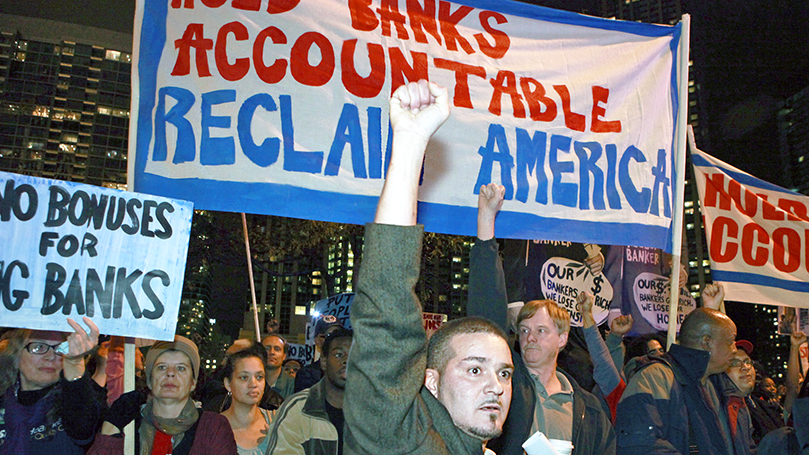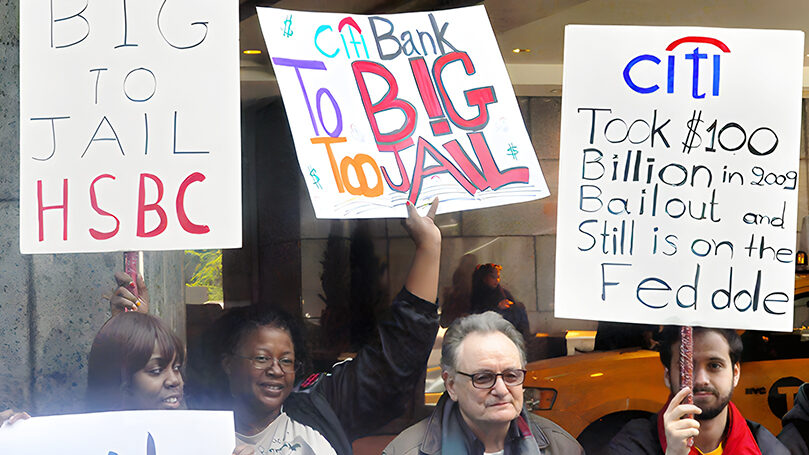
Biden administration officials took extraordinary measures on Sunday to shore up confidence in the financial system after the collapse of Silicon Valley Bank (SVB). Losses from the bank’s collapse were estimated yesterday by Bloomberg at $450 billion, and mounting. While this does not yet compare to the $6 trillion in losses from the 2008 financial crisis, it is still too soon to tell how high the damages may rise.
The Treasury Department, Federal Reserve, and Federal Deposit Insurance Corporation, in a joint announcement, introduced “a new lending program” as a “backstop,” or bailout, for failed bank depositors.
Similar to the 2008 crisis, the plan is for the Federal Reserve to lend money to vulnerable or seized banks at zero interest to cover deposits, even uninsured ones, and avert a “run” on bank deposits across the economy — and not just the U.S. part, by the way.
The Sunday announcement followed the surprise closure of New York’s Signature Bank, along with mounting concerns about spillover effects to other regional lenders and the wider economy.
Let’s be clear: this is nothing less than a bailout, using taxpayer’s dollars.
As Senator Elizabeth Warren has noted, no similar urgent concern from Wall Street has been heard regarding massive and unsustainable student debts. As working people are now being called on to sop up investor risk, the Supreme Court has already begun hearing arguments to deem even partial student debt forgiveness “unconstitutional.”
Silicon Valley Bank specialized in venture capital funding of tech startups. The business model for venture capital investing, simplified, is to fund five startup companies in the expectation that at least one will make it to market, and to pay for all the rest that did not make it, and more. SVB provided cheap, convenient (but less secure) banking and payroll services to startups and their parent venture capital firms. In the process, the bank became severely over-leveraged and the combination of pandemic inflation, followed by rising interest rates — and flirting with flimflam investments like crypto currencies — exposed it all.
Economist Dean Baker notes: “There are two key points that people should recognize about the decision to guarantee all the deposits at Silicon Valley Bank (SVB): [1.] It was a bailout. [2.] Donald Trump was the person responsible.”
The first point is straightforward. “We,” that is, the government on our behalf, provided an insurance policy covering billions of dollars to people (rich SVB depositors and counterparties), who had not paid for it. In naive capitalist apologies, investors are often championed as risk takers. Investment is not insured. It is a gamble. It is not even a loan, which is typically backed by some collateral for protection. Nonetheless, SVB depositors are, once again, “too big to fail.”

SVB has been seized by the Treasury. Perhaps more banks will be seized. The plan for “managing the crisis” appears to be: give out free money to cover deposits, then consolidate failed banks’ assets into larger banks at prices sufficient to recoup the free money. This happened after 2008, resulting in relative recovery, but at the price of an immense consolidation of financial power in fewer hands. The recovery was relative, however, as many economists view the 2008 subprime crisis as a critical turning point, where the long-dominant financial position of the U.S. began to recede.
A new problem, and threat, arises from the free money bailout. It’s termed a “moral hazard.” If the government bails out bad risks, it actually may encourage more risky behavior. In this case, the people who held large uninsured deposits at SVB apparently decided that it was better to risk keeping these uninsured deposits at SVB, rather than, for example, parking their deposits at a larger bank that was subject to more scrutiny by regulators. Baker notes, “They also could have taken ten minutes to examine SVB’s financial situation, which was mostly a matter of public record.”
For whatever reason, the bank’s large depositors chose to expose themselves to serious risk. Now they want taxpayers to foot the bill for a free, retroactive insurance policy.
As pointed to above, this is Donald Trump’s bailout. “It was his decision to stop scrutinizing banks with assets between $50 billion and $250 billion that led to the problems at SVB.”
While it is tempting to blame it all on Trump, the decay of U.S. capitalism and its political institutions on many fronts is a powerful drag — not least on effective financial regulation and industrial policy. A background cause of the SVB failure includes the high volatility of prices, interest rates, and overall supply in many economic sectors. Over-financialization of the economy feeds volatility with repeated bubbles, like crypto currencies. Productive investment, by contrast, builds sustainable value, even if, as Marx predicted, it suffers from a long term decline in the rate of profit.
Note that doubling down on productive investment was the Chinese strategy for countering the 2008 global recession. Indeed, China did not have a recession at all.
What’s it going to take to address the crisis?
- Trump’s deregulation must be rescinded!
- Anti-monopoly regulation is needed! Greater government intervention in, and supervision of, financial services institutions is a must, along with the separation between commercial and investment banking.
- Bailout student debt! This also goes for homeowners and car owners, if the contagion spreads.
- Nationalize the failed banks! If public money is used, the banks should be in public hands. It’s not complicated.
The Fed is in charge of monetary policy, i.e. the money supply. Interest rates and inflation can be influenced by monetary policy; but the latter cannot replace effective, state-led industrial policy in providing stable, global-scale economic growth, and a more scientific — and democratic — management of overall investment, and identification of economic goals, away from parasitic directions.
Images: Hold Banks Accountable by SEIU (CC BY-NC-SA 2.0); Occupy Citibank by Michael Fleshman (CC BY-SA 2.0)


 Join Now
Join Now